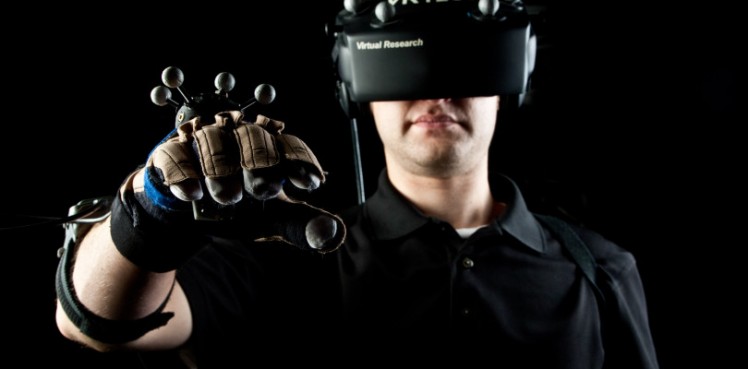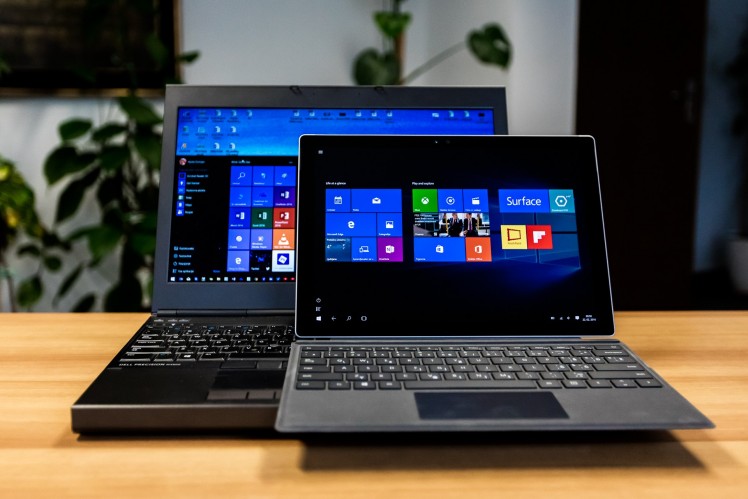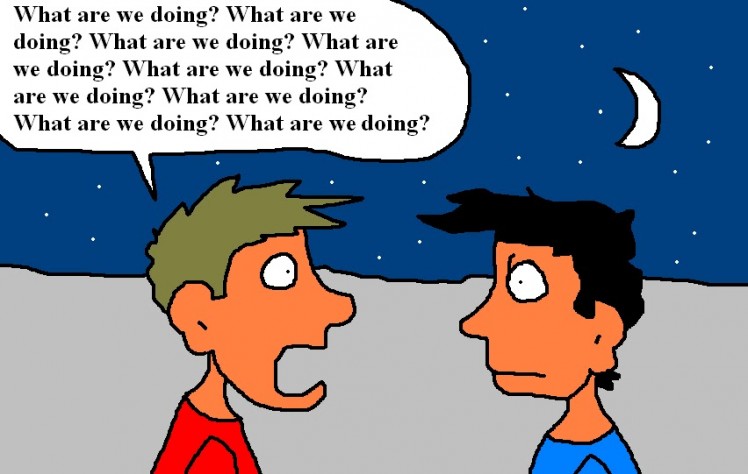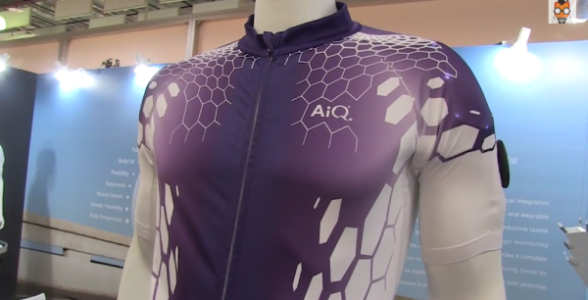Too Fast? It Will Go Even Faster
The rapid development of information technology and telecommunications over the past thirty years has been in fact a benefit of some sort. Whatever activity one was engaged in, be it in the public or private sector, an investment in some computer equipment, software applications and user training made it possible to optimize performance, reduce costs, improve quality and of course increase profit.
Naturally, some did this better than others. Slovenia and a lot of countries did not make the best of this opportunity and went down a few places on the global competitiveness scale. Nothing really dramatic. The cards on the global corporation map have shuffled even more. Apple, Google, Microsoft and Facebook became by far the largest companies in terms of market value in the world. Once the flagship, automotive industry, which is very close to and liked by the Slovenian population as well as perceived as an opportunity for economic growth, slid to somewhere below rank 20 on global list. An illustration that we are experiencing tectonic changes: US Ford and General Motors together are worth only slightly more than for instance Nike, McDonalds or Starbucks and much less than Coca Cola, Pepsi or P&G. All combined are worth less than Apple.
The company that will be the biggest in 20 years has yet to be founded. In the ABC Accelerator I have been following the growth of a new generation of successful companies practically in real time, seeing today that in a few years we will be buying differently, doing business with banks differently and communicating with the public administration differently, and we will have different relations with the electricity, water and heating suppliers … we will travel differently, select hotels differently, go to restaurants differently, undergo treatment differently, and so on. We will allocate most of the money to things we do not know yet today. The key to success is no longer growth and optimization. The companies and countries that don’t invest in novelties will fail completely, regardless of how successful they are and how much profit they make today. I am not talking about just one or a few changes. Even a country like Slovenia will need thousands.
I was surprised by the Chinese at the end of July. Theirs was the first country in the world to introduce online ride-booking regulations. The market with more than a billion users gave the green light to Uber and similar countries, making it clear they need not fear obstacles and pitfalls in winning the Chinese market. This is far from the European practice where mayors of individual towns decide about Uber, AirBnB and similar countries.
I was also surprised by Tesla. The Gigafactory producing batteries needed for its cars was set up in Nevada. At home! This is an excellent example of how innovative companies create jobs without looking for a cheaper labour force around the world. It is worth noting that in less than a year the factory will double the global battery output, only to quadruple it at a later stage, thus filling all Tesla 3 orders. Another trend that will have to be taken into account: foreign companies will no longer be able to create jobs with tax and similar benefits. A slightly different view of the entire matter reveals that investing in domestic knowledge is the only reliable path to a welfare state.
Let us have a look at how Romania boosted its high-tech industry. It reduced taxes, simplified accounting and made it easier to get credit. In a few months it succeeded in reducing unemployment, having recorded one of the lowest unemployment rates among the youth in the EU, ranking second in terms of GDP growth among the EU Member States and looks to have a good future. IT companies account for 6.1% of the country’s GDP and are expected to achieve 10% in 2017. It is important that Adobe, Microsoft, IBM, Intel and Oracle are opening their companies in Budapest because the favourable business conditions there also apply to all, both domestic entrepreneurs and global corporations, thus simplifying the opening of such companies and ensuring the conditions apply to the long-term.
And which country has witnessed the fastest growing GDP? Ireland, which has also reduced corporate income tax, attracted investors and boosted GDP to an incredible 26.3%.
The Russians will become the first to invest in Hyperloop, a new train offered by Elon Musk (Tesla, SpaceX, PayPal, …), operating at a speed of up to 1,200 km per hour. The construction will start in Siberia so as to connect Moscow and Beijing. Great Britain proved to be the most advanced when it comes to drone legislation. Amazon.com will therefore launch drone delivery there.
Who knows what will happen when the door to virtual reality opens really wide!
Original in Slovene Manager.Finance.si/8848155/Aljosa-Domijan-Tehnologija-drvi-kje-bomo-prvi-mi
Welcome to the post app world
For every iPhone sold, 119 apps have been downloaded. However, we use fewer than a quarter of those apps in any given month. The average app loses 77% of its users within three days after being downloaded. The five apps that we love the most take up 80% of our session time.
http://techcrunch.com/2016/04/30/welcome-to-the-post-app-world/
Everything is changing (faster than you can imagine)
Fourth Industrial Revolution is characterized by a range of new technologies that are fusing the physical, digital and biological worlds, impacting all disciplines, economies and industries, and even challenging ideas about what it means to be human.
I dream about it.
Watch the best video about how everything is changing https://www.youtube.com/watch?v=khjY5LWF3tg
First steps in VR-commerce
Excellent experience with Trillenium at Asos in London. VR is next big step in the way we will use our computers, smartphones. Glad to be at least small part of it.
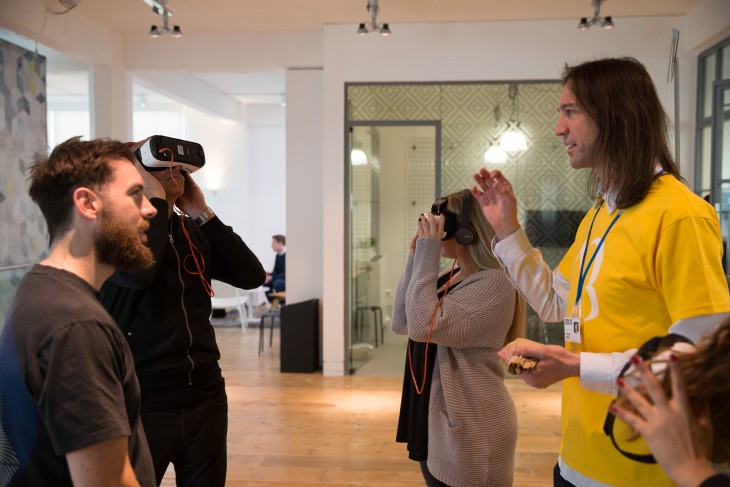
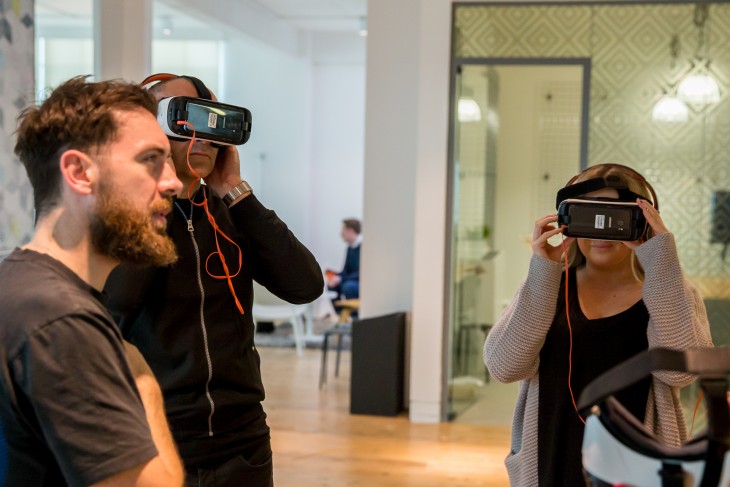
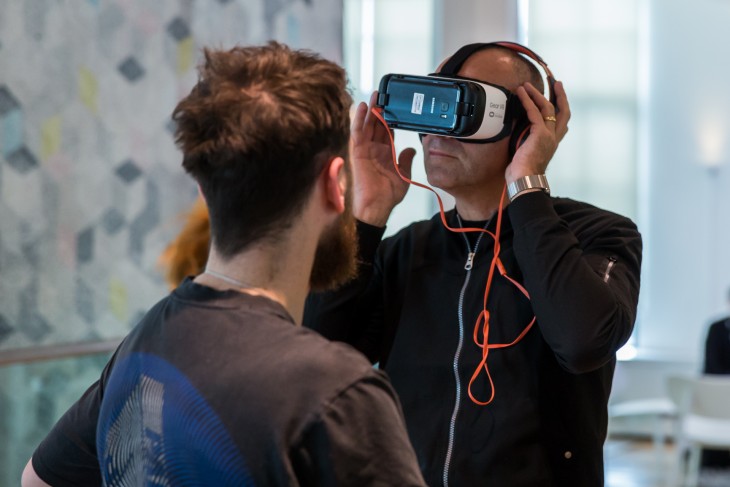

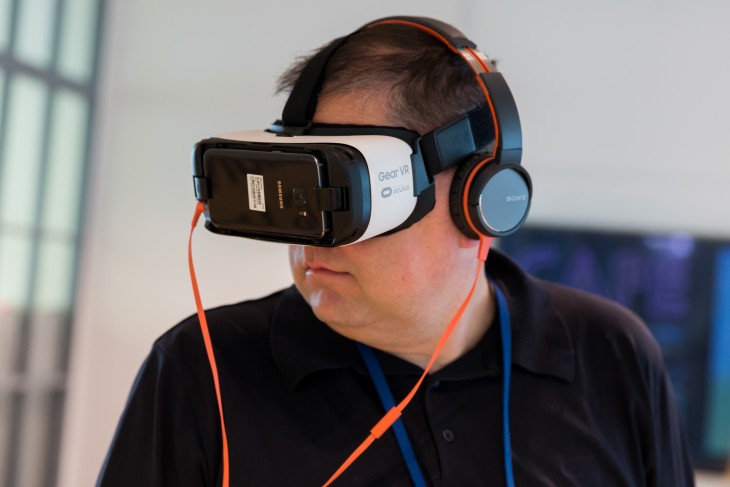
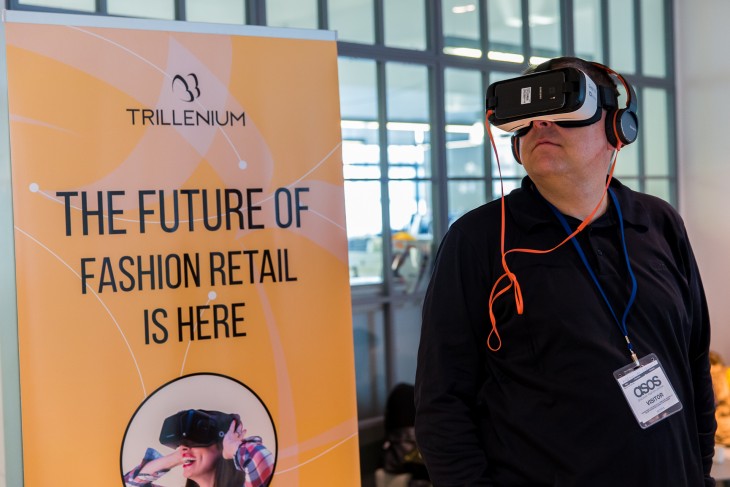
Six Top Technology Trends in 2016
When picking out the most major potentially disruptive tech trends for the new year, I always look at the predictions from the past couple of years. Last year, I drew attention to the Internet of Things, 3D printing, cloud computing, big data, security, data privacy and IT consumerisation. The predictions have all come true; only 3D printing is gaining ground slower than I anticipated.
The jobs we’ve all grown accustomed to are disappearing. Our environment is seeing an influx of people with customs and culture unknown to us. Global stock exchanges are behaving not unlike the fastest and most terrifying roller-coaster ride in the world, the Formula Rossa ride in Abu Dhabi. The news reports about the latest wars have all but replaced bed-time cartoons. We’re getting older: Barbie is already 57, while Tom and Jerry celebrated their 76th birthday this year. All three still have a regular job, only here and there allowing young people to shine.
With all that’s going on, it’s all too easy to forget that there have never been as many people thinking about how to make the world a better and kinder place for more than 10 billion inhabitants, destined to walk the Earth in 2050. At the moment, it seems like nothing special is happening. But this in itself is the greatest of illusions. We are destined to wake up one day, only to find a new futuristic London airport at the mouth of the River Thames; Tokyo will show off its 1.7 kilometre skyscraper, there will be a motorway stretching from London to Beijing, a railway line from Beijing to New York, a motorway traversing what today are inconceivable bridges through Norwegian fjords, there will be a new two-hundred kilometre canal from the Atlantic to the Pacific going through Nicaragua, and Gaudí’s Sagrada Família in Barcelona, under construction since 1882, will have finally been completed. There is no doubt all of this will be possible thanks to new technologies, encompassing everything from new materials and robots to artificial intelligence, virtual reality, 3D printing and modern means of transport.
Some things never change
Once again, as has been the case throughout the years, I have to predict that we will continue to write in MS Word and use MS Excel spreadsheets with almost 100% certainty.
Virtual Reality
When I first met Hrvoje Prpić, I told him that Trillenium somewhat premature. Yeah, a week or two :). However, Trillenium is today the leading builder of VR adventures for retailers.
In March 2014, Mark Zuckerberg once again demonstrated his incomparable prescience, compared to his one hundred billion in their pocket competitors, when he paid two billion dollars for Oculus Rift, what was then an almost non-existent company. This summer, Oculus Rift will release its VR devices for the high retail value of 599 dollars; consumers are expected to spend more than 5 billion dollars this year on playing in virtual reality (the number last year was 660 million).
However, this is not only about video games, even though the gaming industry is planning to not only expand its offer of VR games, but also move it into the cloud. This in turn will also expand the number of cloud services and the need to increase data-transfer rates through the Web and mobile networks. We will be faced with a completely new user experience which will probably no longer include TV screens, monitors, keyboards and PCs. All we’ll need is a smart phone and a virtual reality interface.
Due to all of the changes associated with it and with the consent of the X, Y, Z and millennial generations, virtual reality is the chief trend which will undoubtedly be followed and supported by technological progress in other areas.
Artificial Intelligence
Do you know Amy Ingram? Amy is AI powered personal assistant for scheduling meetings. You interact with her as you would with other person. Here you can get Amy for free.
When five years ago, Apple started equipping its smartphones with Siri, most users never even considered it was a form of artificial intelligence. In 2016, Amy, Siri, Google Now, Alexa and Cortana will become completely run-of-the-mill.
Nowadays, we are already used to computers doing more administrative tasks than people; they are better at seeing, hearing, recognizing patterns, etc. It will take some getting used to the fact that they will also be making better conclusions. It is a fact that only the crunching power of computers can find better solutions in big data by using software with artificial intelligence characteristics. IBM’s Watson is proof of this concept, while Amy, Siri and Cortana will offer a friendly helping hand when dealing with artificial intelligence.
Smart Devices
The expression “smart devices” is used for everyday products which collect data through Wi-Fi or Bluetooth networks and are controlled via smartphone apps. This year, a growing number of chairs, lawnmowers, refrigerators, cups of coffee and door handles will be sending out data. Most of them only collect data on when they are being used, for how long and at what time of the day; others also measure air humidity and temperature.
However, smart devices are also smart houses and the Internet of Things. If we look at it with an even wider angle, these devices also include robots, drones and, at the end of the day, smart cars. Simply put, computers will be everywhere. Everything will be interconnected. Devices will send and use data from the cloud. It’s up to us to get ready and take advantage of it.
Mobile Payments
Banks are behind with the times. Banks are cumbersome. So say the start-up companies looking to bring a breath of fresh air to how we pay for things. It’s a fact that banks are losing the payment transaction business. Goldman Sachs reports that financial start-ups will take over banking services worth at least 4.7 trillion dollars per year.
Investors had already detected this trend in 2014 and invested 12 billion dollars into new companies. Europe thus already has three unicorns – companies whose valuation has quickly exceeded a billion dollars: Adyen, Powa, and Skrill. On the global market, they will be forced to compete with Stripe, WePay, and Betterment.
This is not all down to the rigidity of traditional banks. The rapid growth of companies, such as Airbnb and Uber, is bringing new requirements to the financial services market. Such needs can only be met by new innovative companies. As a cherry on top, new entrants to the market are starting to use web-based and mobile services to offer better student loans and customer support for users without bank accounts. At the moment, this represents a pool of 2.5 billion people.
Media
An increasing number of users access media through Facebook, Twitter and other social networks; this means less and less people are accessing content through the media outlets’ home pages. According to Pew Research, this habit has been taken up by almost two-thirds of U.S.-based users. The phenomenon is only expected to grow. As is often the case, the rest of the world is certain to follow this trend in 2016. It’s interesting to note that analysts didn’t find any deviations among demographic groups. The trend exists with all generations, regardless of gender or social status.
The habits of television viewers have also been changing; they increasingly prefer to stream films and series via the Internet. This allows them to watch whatever they want, whenever they want it. In 2016, the obvious shift of attention to content-oriented users will represent a challenge for the mainstream media. They will need to figure out how to improve their offer, while retaining their popularity, visibility, and subscribers.
Tablets are out
Tablets are out. Apple didn’t come to MWC. Samsung, Sony, HTC and LG didn’t have any new tablet to announce. Tablets are now just a commodity for less than 200 €. No additional value. Profit gone. VR works fine with phones or laptops. I’m sure there will soon find a place on smart televisions, too.
From one side phones are getting bigger (5.3-inch displays) and from another: new generations of MS Surface Pro like devices with Windows 10 which technically are neither tablets or laptops is already on the market. Is it the end of laptops era, too? Two weeks after the launch in Slovenia MS Surface Pro is already on TOP 10 EnaA ranking list.
In June Oculus Rift will certainly change everything again.
Director’s Test Surface Pro 4 for Directors
When Microsoft started selling MS Surface Pro 4 tablets/notebooks with an announcement that this was the right choice for directors and other executives who travel a lot and need a reliable tablet with the capacity of a computer, I immediately asked for this tablet for testing purposes. Until the conclusion of this test and submission of the article to the editor, I was following the news of how Microsoft has been beating the competition with Surface Pro 4 and reading about other tests.
Well, here comes the first real director’s test. As a startup investor, I need a laptop to access networks of a large number of companies with whom I cooperate; access to analytical data on the operations of enaA.com, the largest online retailer in the region; access to a large number of bank accounts and the stock exchange; graphic software to review the marketing materials sent for approval; several Facebook, Twitter and LinkedIn profiles; MS One Drive, MS OneNote, Dropbox, Skype and more. Let me tell you that I use no less than six Internet browsers for my work. In short, I am a very busy user who needs a director’s convenience, a screen for a graphic designer and technology for an engineer. At the same time.
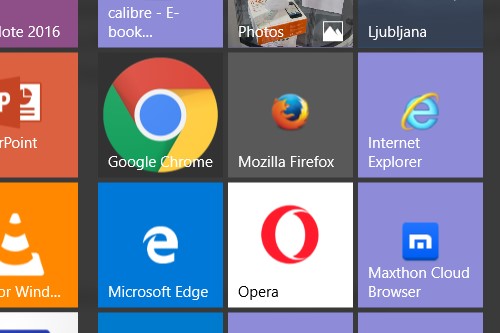 Do you know six Internet browsers?
Do you know six Internet browsers?
Top Design and AI
In several months, this kind of computer will be an obligatory purchase for every manager. I am saying “this kind”, because Microsoft is bound to get copycats. With MS Surface Pro 4, managers have got a device to take them to the next technological period. By all means, the device is a designer eye candy, one that your partners will notice at every meeting. The manufacture is flawless. Every detail has been taken care of.
What is more, it has built-in artificial intelligence: you can give orders to Cortana in English. Find this, find that, open enaA.com website, today’s presentation… Yes, this is not a movie. At the same time, Cortana diligently records your choices and manner of working, so that your cooperation with your digital personal assistant is becoming ever more smooth.
Light
I carry my laptop with me at all times. But my current laptop – though it is a bit more capable than MS Surface Pro 4 – weighs no less than 3.5kg. I hate to leave it in the car, so I sometimes take it with me when I go for a cup of coffee with someone. It looks rather odd, but it is preferable to having it stolen.
Microsoft Surface Pro 4 weighs only 1.1kg, keyboard included. In addition, because it is smaller and thinner, I can put it in my bag and carry it with me without anyone noticing. Truth be told, even I forget that I have been carrying it around.
A Battery That Lasts… and Lasts
I have worked on laptop battery power nearly all the time. When I was writing this article and doing some other things, the battery lasted five hours. When I was surfing the Internet over the weekend, I browsed Facebook and read the news, and the battery lasted an incredible 8 hours. The batteries are re-charged in a good two hours.
Excellent Keyboard
At meetings, I have invariably used Microsoft Surface Pro 4 as a tablet. The one touch works flawlessly. More or less, I have been using the keyboard when travelling or at home. The keyboard attaches itself to the tablet with a strong magnet. And it holds! Surprise fact: the keyboard is big, robust and excellent for typing. The illuminated keys are pleasant to touch and the spaces between them are big. I wrote nearly the entire article with this keyboard.
The Screen
At 12.3 inches, the screen is a bit too small for my taste. Yet, had the screen been bigger, it would be less easy to handle and would not fit into every bag. At the workplace, you can connect it to a docking station with two large external monitors of your choice.
The Docking Station
The docking station is one more proof that this is a professional device. At your workplace, simply connect it to the docking station to which you can connect two large external monitors of your choice and there you go, you have a capable laptop in front of you.
Windows 10
Microsoft Surface Pro 4 would not be as good as it is without Windows 10. Personally, I think Windows 10 looks even more attractive on a 12.3 inch screen, although Windows 10 works equally well on both devices. Well, at least I have used it in the same way.
Final choice
Approximately two years ago, I was deciding between an Apple MacBook and a MS Windows laptop. At that time, I concluded the following:
Apple MacBook is more modern, attractive-looking, lighter and more user-friendly. If what you do for your work needs a single screen – and this suffices most designers, authors, programmers, developers and many managers – then you are bound to be delighted with it. Managing all of the applications on the screen (or up to four screens) with your fingers or a mouse is excellent. It gives a new dimension to creativity. If you use any special software (mostly for design, video processing, photography, etc.) then I have no doubts about Apple being the perfect choice.
Yet for a heavy user – i.e. a heavy miner who constantly switches between at least five websites, uses five additional applications, needs a safe access anywhere to any of the background services of enaA.com, manages several projects which include collaborators from several companies – Apple does not provide sufficient transparency and efficiency. The problems with online banking were the final straw and I decided to keep on using a laptop with the classic MS Windows and Office combination. Working on two laptops with different operating systems does not work well in the long run. I cannot say that I was not sorry when I was erasing my data from Apple’s MacBook, but that how things are.
This time, I have made a comparison with my two months’ old laptop with the following configuration DELL Precision M4800 and MS Surface Pro 4 12.3″ /2736 x 1824 / i5 / 4 GB / 128GB / INTEL HD 520 / WIN 10 PRO.
MS Surface Pro 4 has everything I liked two years ago with the Apple MacBook and a MS Windows computer. Therefore, there is no doubt that today I would buy MS Surface Pro 4: it is a light, yet robust and a top user-friendly product which allows you to work transparently with several applications and switch effortlessly between different environments. In short, it has everything I need. This is a work computer, a laptop and a tablet – 3 in 1. It is something I need as a director, as an IT professional and as a person who works with graphic designers.
Of course, I am going to buy the more capable model MS Surface Pro 4 12.3″/2736 x 1824/ i7 /8 GB/256GB/INTEL HD 520/WIN 10 PRO
Kako bi mi birokratsko ubili Izo in Sama Logina
Ali bi bili pripravljeni za podjetje, ki nima lastnih prostorov in opreme, ima le nekaj več kot deset zaposlenih in ponuja brezplačno storitev, odšteti milijardo dolarjev? Facebook je na primer spomladi 2012 kupil Instagram za okroglo milijardo dolarjev. Vsi Slovenci in Slovenke, s katerimi sem se o tem pogovarjal, so bili prepričani, da je šlo v tem primeru za uveljavljeno podjetje z nekaj tisoč zaposlenimi, nepredstavljivo količino strežnikov in druge računalniške opreme. V resnici pa ste Kevin Systrom in Mike Krieger podjetje ustanovila oktobra 2010. Priljubljenost spletne storitve, ki omogoča delitev fotografij in videoposnetkov, je neverjetno hitro rasla, tako da so se po letu in pol že lahko pohvalili s sto milijoni aktivnih uporabnikov in 13 zaposlenimi. Ker podjetje drugega imetja pravzaprav niti ni imelo, vse je bilo namreč najeto, je Mark Zuckerberg za vsakega uporabnika brezplačne storitve plačal deset dolarjev.
Odločitev ni bila lahka: to je bila četrtina denarja, s katero je takrat razpolagal Facebook. Za primerjavo: Microsoft je v približno istem času kupil knjigarnarja Barnes & Noble, podjetje s seznama Fortune 500, s 658 knjigarnami ter dodatnimi 705 študentskimi knjigarnami največjega prodajalca knjig v ZDA, zgolj za 605 milijonov dolarjev. Tudi Microsoft precej globlje seže v žep, ko kupuje »mala« spletna podjetja. Ni šale, lo kupujejo Sergey Brin, Larry Page, Satya Nadella in Mark Zuckerberg, milijarde padajo.
Samo Google je od leta 2001 do danes za nakup podjetij porabil 28 milijard, med drugim za Youtube 1,65 milijarde in za DoubleClick 3,1 milijarde. Za priljubljeno igro Minecraft je Microsoft pred nekaj dnevi plačal že 2,5 milijarde dolarjev.
Če bi bil Outfit7 slovensko podjetje
Trenutno najbogatejša Slovenca Samo in Iza Login svojega podjetja sicer še nista prodala, a prepričan sem, da bosta zanj dobila precej več kot ocenjenih 1,1 milijarde evrov. Njuno podjetje je samo v treh letih z več kot milijardo naloženih Talking Tomov svetovni fenomen. In tudi onadva nimata toliko nepremičnin in zaposlenih kot Telekom Slovenije. Torej bolj ali manj enaka zgodba kot pri Minecraftu, Instagramu ali Yammerju.
Če bi Outfit7 postavil Talking Toma kot slovensko podjetje v Sloveniji in ga prodajal iz Slovenije, bi moral najprej narediti vse vmesnike v slovenskem jeziku, napisati, da poslujejo v slovenskem jeziku in našteti še preostale jezike. Na njihovi spletni strani bi moralo vse uporabnike na svetu čakati opozorilo, da njihovi piškoti ne škodijo, ter prošnja, da obiskovalci s klikom na »da« potrdijo soglasje za uporabo piškotov na njihovih straneh. O tem, kako Talking Tom spoštuje zasebnost, bi odločala naša informacijska pooblaščenka. Dobro smo si zaprli vrata, ali ne!
Z isto pametjo in delom si lahko revež ali pa milijarder
Kako globoko je nerazumevanje sodobnih trendov v našem okolju, pokaže tudi hiter vpogled na področje zakonodaje, ki ureja avtorsko delo in pravice. Kot avtorja, ki ne bi bila v delovnem razmerju, bi bila Samo in Iza Login za svoj honorar obremenjena s približno 79 odstotki.
Če pa bi po nekem naključju Talking Toma narisala kot zaposlena v kateri izmed slovenskih marketinških agencij za TV-reklamo ali morda kot aplikacijo za Murino majico, bi bila reveža. Njuna ideja bi pripadla podjetju, v katerem bi delala.
Slovenska zakonodaja namreč v zakonu o avtorski in sorodnih pravicah v 101. in 102. členu še vedno odreja: »Kadar avtorsko delo ustvari delojemalec pri izpolnjevanju svojih obveznosti ali po navodilih delodajalca (avtorsko delo iz delovnega razmerja), se šteje, da so materialne avtorske pravice in druge pravice avtorja na tem delu izključno prenesene na delodajalca za deset let od dokončanja dela, če ni s pogodbo drugače določeno.« In praviloma ni določeno. Na koncu bi najverjetneje ustrezno zakonsko podlago za nekaj svojih odstotkov našel tudi Sazas.
Hiša z vrtom
Z isto idejo in istim delom bi bila Samo in Iza Login v Sloveniji v najboljšem primeru vesela, da bi našla rešitve za vse birokratske ovire in bi potem kot podjetnika lahko sproti plačevala vse račune in davke, imela bi hišo z vrtom in srednje dober avto, zunaj Slovenije pa sta na poti do statusa milijarderjev. Se še sprašujete, kje Slovenija izgublja denar? Kot je povedal Joc Pečečnik, eden izmed najbogatejših Slovencev: »Povsod po svetu sem znal zaslužiti, doma pa niti evra.«
Mi bi še šivali srajce
Seveda je vprašanje, kako bo brez sprememb lahko kdorkoli zaslužil dovolj. Če na eno stran postavimo milijardo dolarjev, ki jo ustvari vsega nekaj ljudi v dveh ali treh letih, in na drugo stran dodano vrednost v proizvodnih podjetjih, je nesorazmerje očitno. Nemogoče je danes narediti toliko srajc, kot lahko naložiš aplikacij. Mi pa še vedno iščemo vlagatelje, ki bi vlagali v proizvodnjo srajc, in odganjamo celo tiste Slovenke in Slovence, ki znajo zaslužiti s svojimi idejami, znanjem in kreativnostjo.
Prvič objavljeno 11.11.2014 http://www.finance.si/8812590/Kako-bi-mi-birokratsko-ubili-Izo-in-Sama-Logina
Za pametne naprave v oblačilih 19 milijard evrov
V času, ki ga v Sloveniji potrebujemo za sestavo vlade, se obseg vsega znanja na svetu podvoji. Nove tehnologije, vse večja hitrost prenosa podatkov in umetna inteligenca omogočajo neverjetno rast obsega znanja, ki ga ima na voljo človeštvo.
Na spletu sem poiskal odgovore, kako hitra je dejansko ta rast. Naletel sem na tole razmišljanje: če upoštevamo, da se število ljudi na zemlji podvoji vsakih 50 let ter da vsak človek podvoji svoje znanje vsakih 25 let, dodamo rojstva, smrti, vojne, naravne nesreče, staranje prebivalstva, potem se obseg človeškega znanja najverjetneje podvoji vsakih 75 let.
Od leta nič
Logično razmišljanje, mar ne? Vendar pa je Buckminster Fuller že leta 1980 pokazal, da je to veljalo okoli leta 1900. James Appleberry je izračunal, da se je človeško znanje od leta nič prvič podvojilo okoli leta 1750. Nato je za podvojitev potrebovalo samo še približno sto let.
Od konca druge svetovne vojne pa obseg znanja raste eksponencialno (tisti, ki se spominjate, kako so rasle obresti pred razpadom Jugoslavije, si verjetno lažje predstavljate, kaj to pomeni). Takoj po drugi svetovni vojni se je podvojilo vsakih 25 let.
Bill Clinton je v času, ko je bil predsednik ZDA, predstavil podatek, da se človeško znanje podvoji vsakih pet let. Tudi v študiji, ki jo je naročil in objavil Unesco leta 2003 ter povzema tudi več kot pet let stare raziskave, so ugotovili, da se človeško znanje podvoji vsakih pet let, ter predvideli, da se bo leta 2020 podvojilo že vsakih 73 dni. Že okoli leta 2000 pa so analitiki opozorili, da smo ljudje sposobni spremljati le še od pet do deset odstotkov novih informacij.
V 12 urah
Hitrost pa raste. Leta 2010 je veljalo, da se obseg znanja na svetu podvoji vsakih 13 mesecev. Na poti do podvojitve v 73 dneh leta 2020 smo danes nekje na polovici. IBM že napoveduje čase, ko se bo človeško znanje podvojilo v 12 urah. Neverjetno, ali ne? A Japonci so že napovedali, da bodo na olimpijskih igrah leta 2020 omogočili samodejno prevajanje v realnem času in prenos holografske slike. Japonci svoje obljube vedno izpolnijo.
Če ostanemo pri letu 2020, lahko z veliko gotovostjo napovemo, da bomo takrat vsak dan prek spleta posredovali podatke več kot 450-milijardkrat. V Evropi bomo imeli 62 odstotkov obnovljivih virov energije. O internetu stvari ne bomo več samo govorili. Pametna mesta in pametni domovi bodo realnost. Samo za pametne domove bomo porabili 52 milijard evrov na leto. Za pametne naprave, vgrajene v naša oblačila, bomo porabili 19 milijard evrov. Prek spleta bo povezanih 90 odstotkov osebnih avtomobilov. V povprečju bomo potrebovali dostop do gigabajta podatkov na dan. Zato potrebujemo hitrejša omrežja. Potrebujemo razvoj. Potrebujemo hitrost. Potrebujemo nove poslovne ideje.
Kje smo mi?
Kako bomo kot Slovenija našli prostor zase, če ob tem, ko svet okrog nas vsakih nekaj mesecev podvoji znanje, sami še vedno nismo našli odgovorov na vprašanja o težavah naših bank, predragi javni upravi, boljšem zdravstvu, skratka o vsem, kar nas teži že vsaj zadnjih šest let? Šest let. V tem času bi morali za to, da držimo korak s svetom, naše znanje skoraj podeseteriti.
V Sloveniji je zdaj že 40 odstotkov ljudi starejših od 50 let ( www.stat.si/Piramida2.asp ), ki so v povprečju izgubili okoli 60 odstotkov svojih kognitivnih sposobnosti. Za lažje razumevanje naj naštejem najpomembnejše kognitivne (miselne) sposobnosti: mišljenje, orientacija v prostoru, razumevanje, računanje, učenje, govor, presoja …
In s tem gremo na pogovore o internetu stvari, industriji 4.0?
Prvič objavljeno 26.8 v časniku Finance
http://www.finance.si/8808362/Za-pametne-naprave-v-obla%C4%8Dilih-19-milijard-evrov
Zbogom, Windows 2003, zbogom, IT, kot smo ga poznali!
Pred tedni sem na obisku pri slovenskem predstavništvu mednarodne korporacije z nekaj deset tisoč računalniki izvedel, da imajo še vedno domeno na strežniku Windows 2003. Res je (bil) dober!
Dan kasneje me je dosegla novica, da bo Microsoft 14. julija 2015 ukinil podporo za Windows 2003. Na svetu naj bi ta trenutek uporabljali še več kot 9 milijonov teh strežnikov. V naslednjem letu bi torej morali IT strokovnjaki zamenjati več kot 25 tisoč strežnikov vsak dan. Hewlett Packard se je potrudil in vsem svojim partnerjem po svetu že poslal oceno stroškov te menjave: 10 milijard dolarjev. Poslovna priložnost desetletja, so jo poimenovali.
Presenečenje
Ker se v praksi večinoma ukvarjam z uvajanjem novih tehnologij, me je, priznam, razširjenost strežnika Windows 2003 presenetila. Podjetja, s katerimi sodelujem, so v desetih letih zamenjala večino drugih strežnikov. Razumljivo, če ne bi preskočila na na primer MS Exchange 2013, uporabniki ne bi imeli dostopa do elektronske pošte preko spleta, ki ga potrebujejo, če želijo do svojih poštnih predalov dostopa preko pametnih telefonov in tabličnih računalnikov.
Vmes pa so strežniki Windows 2003 tiho stregli.
Tudi to je verjetno razlog, da večina podjetij o spremembi doslej ni razmišljala. Strežniki bodo seveda delali tudi po 14. juliju 2015, tako da ni razlogov za paniko in selitev se bo verjetno zavlekla za kakšno leto ali dve. Tudi zato, ker podjetja, kot ocenjujejo pri HP, za prehod na novo okolje potrebujejo vsaj okrog 200 dni. Torej, prišel je čas, ko se bo treba od Windows 2003 strežnikov posloviti. A tokrat lahko prvič v zgodovini kupite nov strežnik ali pa greste preprosto v oblake. Kako se boste odločili?
IT sistemi danes delujejo skoraj 100%. Izdelki se ne kvarijo, za njihov vklop v sisteme pa ne potrebujete strokovnjakov. Vklopite in dela. Zato je vse stroškov z vzdrževanjem. Tudi varovanje podatkov, arhiviranje, zaščita pred vdori in podobna vprašanja niso več glavna IT tema v podjetjih. To preprosto mora biti. Cena strežnikov in terabajtov je nekajkrat nižja kot pred leti. Če želite ostati na svojem, s svojimi strežniki, ne bo nič narobe.
Trend so oblaki
Vso vašo elektronsko pošto, podatke in aplikacije lahko poganjate preko oblakov. Trend je vse večja uporaba pametnih telefonov in tablic. Prodaja računalnikov in notesnikov pada že nekaj let. Do leta 2020 bo polovica e-nakupov opravljenih preko mobilnih naprav. Vse pogosteje se podjetja odločajo tudi za BYOD – Bring Your Own Device, BYOP (Prinesi svoj pametni telefon) in BYOPC (Prinesi svoj PC). Gre za naravno nadaljevanje spreminjanja odnosa do tehnologije in njene uporabe, ko podjetja dovoljujejo zaposlenim, da na delo prinesejo svoj PC, notesnik, tablico ali pametni telefon in z njim dostopajo do sicer zaščitenih poslovnih podatkov, namesto da dovoljujejo zaposlenim, da službeni notesnik in telefon uporabljajo tudi za osebne namene. Če zadevo obrnemo tako, naj bi bilo v to vključenih že več kot 60% poslovnih uporabnikov. Na nek način so vsi ti vsaj z eno nogo že trdo v oblakih.
Napoved
Brez zadržkov lahko napovem, da bo število strežnikov v lasti podjetij od leta 2015 dalje hitro padalo. A kakorkoli se boste odločili, boste pristali pri Microsoftu. Ali skozi na primer HP-Microsoft Windows Server 2003 program migracije ali pa s prehodom na MS Office 365, kjer dobite že danes v paketu brezplačno še neverjetnih 1TB pomnilnika v OneDrive oblaku.
Prvič objavljeno v časniku Finance 5.avgusta. 2014
http://www.finance.si/8807245/Zbogom-Windows-2003-zbogom-IT-kot-smo-ga-poznali



